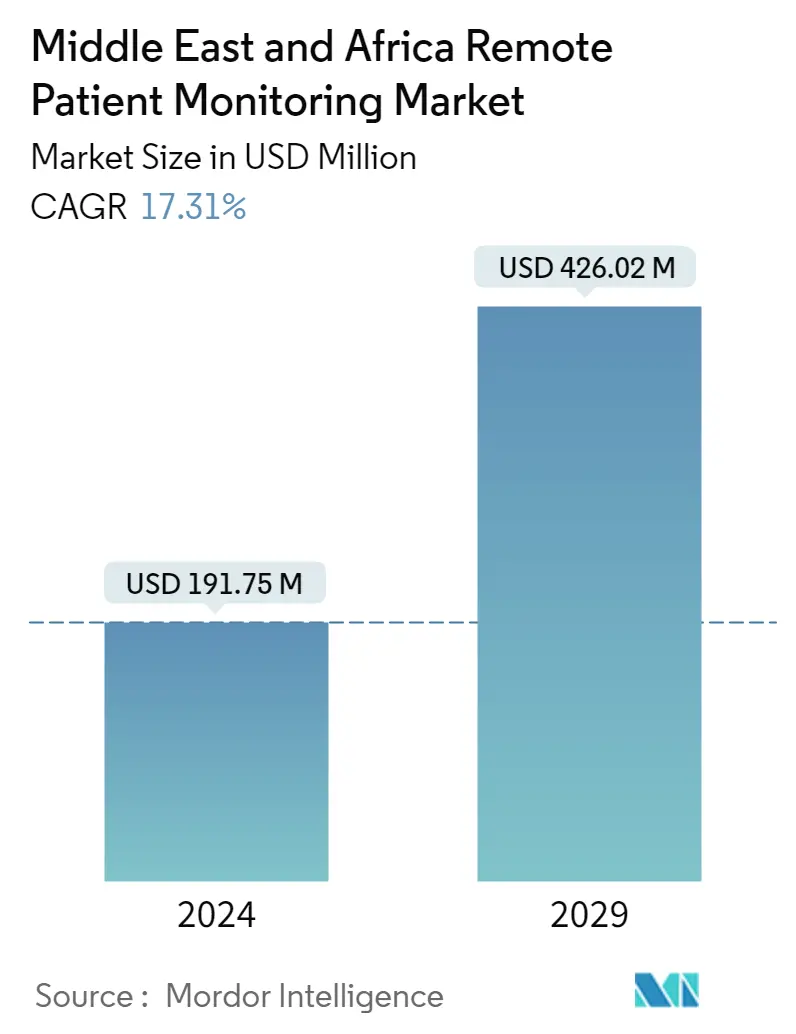Market Size of Middle East & Africa Remote Patient Monitoring Industry

| Study Period | 2019 - 2029 |
| Base Year For Estimation | 2023 |
| Market Size (2024) | USD 191.75 Million |
| Market Size (2029) | USD 426.02 Million |
| CAGR (2024 - 2029) | 17.31 % |
| Market Concentration | Medium |
Major Players
*Disclaimer: Major Players sorted in no particular order |
MEA Remote Patient Monitoring Market Analysis
The Middle East & Africa Remote Patient Monitoring Market size is estimated at USD 191.75 million in 2024, and is expected to reach USD 426.02 million by 2029, growing at a CAGR of 17.31% during the forecast period (2024-2029).
The COVID-19 pandemic placed enormous pressure on hospitals and healthcare systems that were understaffed and overworked. Remote patient monitoring technology helped patients remain safe within their homes while reducing stress on hospitals, emergency rooms, and front-line healthcare workers during the pandemic, thereby positively impacting the market. According to an article published by Pharmacy Practice, in June 2022, pharmaceutical care in the UAE changed after COVID-19 in terms of medication dispensing, patient-centered roles, and remote services. Also, from the early beginnings of the pandemic, the UAE issued regulations to facilitate the delivery of healthcare services remotely in community and hospital pharmacies. Remote patient monitoring has demonstrated the ability to enhance health outcomes and reduce chaos during the pandemic which made the hospitals realize the advantage of RPM over traditional systems. Hence, the demand for remote patient monitoring systems increased, eventually driving market growth.
Factors such as rising incidences of chronic diseases due to lifestyle changes and rising demand for home-based monitoring devices are driving the growth of the market. For instance, per an article published by the National Library of Medicine in March 2022, the growing prevalence of non-communicable chronic diseases (NCDs) is placing increased pressure on healthcare systems, mainly primary healthcare. Many patients with NCDs do not receive treatment that meets their needs, even in well-managed integrated delivery systems. Therefore, the increasing NCDs and the improved healthcare systems demand remote patient monitoring devices and are expected to drive market growth.
In addition, these devices are compact and portable, and patients can wear them all day without feeling uneasy. These devices also ensure that the patient's condition is monitored continuously. Growing demand for home-based monitoring devices also boosts the market's growth. According to the Center for Medicare and Medicaid Services, 2021, several high-risk patients can prolong their healthy days at home and avoid being readmitted to the hospital because of remote monitoring. Remote monitoring clients report a 76% decrease in readmission rates, an average patient satisfaction rating of 89%, and overall medical cost savings of almost USD 370 million in the previous year.
Thus the above-mentioned factors are expected to drive the growth of the market over the forecast period. However, resistance from healthcare industry professionals toward the adoption of patient monitoring systems and lack of proper reimbursement are the factors impeding the market's growth.
MEA Remote Patient Monitoring Industry Segmentation
As per the scope of the report, remote patient monitoring comprises day-to-day monitoring devices, such as glucometers for patients with diabetes and heart or blood pressure monitors for patients getting cardiac care. Information can be sent to a physician's workplace via telehealth communication links and a software application installed on the patient's internet-capable computer, smartphone, or tablet. The Middle East & Africa remote patient monitoring market is segmented by type of device (heart monitors, breath monitors, hematology monitors, multi-parameter monitors, and other types of monitors), applications (cancer treatment, cardiovascular diseases, diabetes treatment, sleep disorder, weight management, and fitness monitoring, and other applications), end user (home care settings, hospitals/clinics, and others), and geography (GCC, South Africa, rest of the Middle East and Africa). The report offers the value (in USD) for the above segments.
| By Type of Device | |
| Heart Monitors | |
| Breath Monitors | |
| Hematology Monitors | |
| Multi-Parameter Monitors | |
| Other Types of Monitors |
| By Application | |
| Cancer Treatment | |
| Cardiovascular Diseases | |
| Diabetes Treatment | |
| Sleep Disorder | |
| Weight Management and Fitness Monitoring | |
| Other Applications |
| By End User | |
| Home Care Settings | |
| Hospital/Clinics | |
| Others |
| Geography | |
| GCC | |
| South Africa | |
| Rest of Middle East and Africa |
Middle East & Africa Remote Patient Monitoring Market Size Summary
The Middle East & Africa remote patient monitoring market is experiencing significant growth, driven by the increasing prevalence of chronic diseases and the rising demand for home-based monitoring devices. The COVID-19 pandemic highlighted the importance of remote monitoring technologies, as they alleviated pressure on healthcare systems by allowing patients to receive care at home. This shift has led to a greater acceptance of remote patient monitoring over traditional systems, thereby boosting market expansion. The compact and portable nature of these devices, which ensure continuous monitoring without discomfort, further contributes to their growing adoption. Despite challenges such as resistance from healthcare professionals and reimbursement issues, the market is poised for substantial growth over the forecast period.
In the Gulf Cooperation Council (GCC) region, factors such as an aging population, the rising incidence of chronic disorders, and technological advancements are propelling market growth. The increasing burden of cardiovascular diseases, particularly in the UAE, underscores the need for effective monitoring solutions. Strategic collaborations and product launches, such as those by BioIntelliSense and Ortus iHealth, are expected to enhance market dynamics. The competitive landscape features both international and regional players, including Boston Scientific, Masimo, and Medtronic Plc, which are instrumental in shaping market trends. Overall, the Middle East & Africa remote patient monitoring market is set to expand significantly, driven by technological innovations and increasing healthcare demands.
Middle East & Africa Remote Patient Monitoring Market Size - Table of Contents
-
1. MARKET DYNAMICS
-
1.1 Market Overview
-
1.2 Market Drivers
-
1.2.1 Rising Incidences of Chronic Diseases Due to Lifestyle Changes
-
1.2.2 Rising Demand for Home-based Monitoring Devices
-
-
1.3 Market Restraints
-
1.3.1 Resistance from Healthcare Industry Professionals Toward the Adoption of Patient Monitoring Systems
-
1.3.2 Lack of Proper Reimbursement
-
-
1.4 Porter's Five Force Analysis
-
1.4.1 Bargaining Power of Suppliers
-
1.4.2 Bargaining Power of Buyers/Consumers
-
1.4.3 Threat of New Entrants
-
1.4.4 Threat of Substitute Products
-
1.4.5 Intensity of Competitive Rivalry
-
-
-
2. MARKET SEGMENTATION (Market Size by Value - USD)
-
2.1 By Type of Device
-
2.1.1 Heart Monitors
-
2.1.2 Breath Monitors
-
2.1.3 Hematology Monitors
-
2.1.4 Multi-Parameter Monitors
-
2.1.5 Other Types of Monitors
-
-
2.2 By Application
-
2.2.1 Cancer Treatment
-
2.2.2 Cardiovascular Diseases
-
2.2.3 Diabetes Treatment
-
2.2.4 Sleep Disorder
-
2.2.5 Weight Management and Fitness Monitoring
-
2.2.6 Other Applications
-
-
2.3 By End User
-
2.3.1 Home Care Settings
-
2.3.2 Hospital/Clinics
-
2.3.3 Others
-
-
2.4 Geography
-
2.4.1 GCC
-
2.4.2 South Africa
-
2.4.3 Rest of Middle East and Africa
-
-
Middle East & Africa Remote Patient Monitoring Market Size FAQs
How big is the Middle East & Africa Remote Patient Monitoring Market?
The Middle East & Africa Remote Patient Monitoring Market size is expected to reach USD 191.75 million in 2024 and grow at a CAGR of 17.31% to reach USD 426.02 million by 2029.
What is the current Middle East & Africa Remote Patient Monitoring Market size?
In 2024, the Middle East & Africa Remote Patient Monitoring Market size is expected to reach USD 191.75 million.

